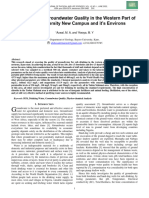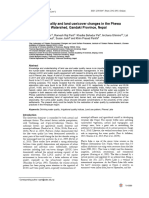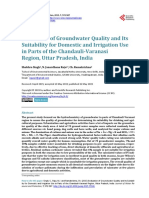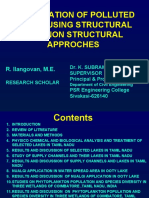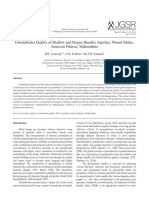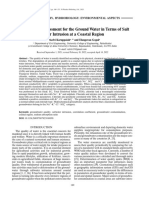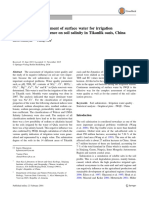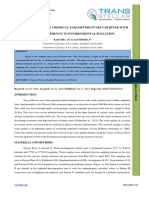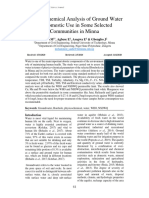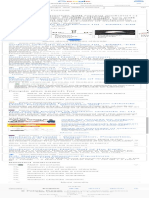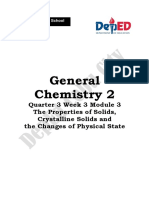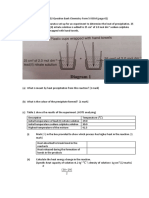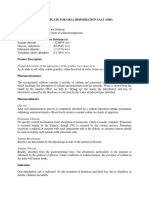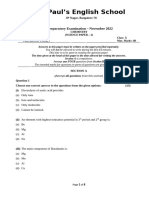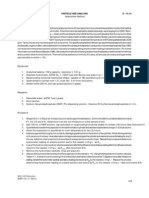Evaluation of Surface Water Quality and Its Suitability For Drinking and Agricultural Use in Jalgaon District, Maharashtra, India
Evaluation of Surface Water Quality and Its Suitability For Drinking and Agricultural Use in Jalgaon District, Maharashtra, India
Uploaded by
AJ ONLINECopyright:
Available Formats
Evaluation of Surface Water Quality and Its Suitability For Drinking and Agricultural Use in Jalgaon District, Maharashtra, India
Evaluation of Surface Water Quality and Its Suitability For Drinking and Agricultural Use in Jalgaon District, Maharashtra, India
Uploaded by
AJ ONLINEOriginal Title
Copyright
Available Formats
Share this document
Did you find this document useful?
Is this content inappropriate?
Copyright:
Available Formats
Evaluation of Surface Water Quality and Its Suitability For Drinking and Agricultural Use in Jalgaon District, Maharashtra, India
Evaluation of Surface Water Quality and Its Suitability For Drinking and Agricultural Use in Jalgaon District, Maharashtra, India
Uploaded by
AJ ONLINECopyright:
Available Formats
Nature Environment and Pollution Technology ISSN: 0972-6268 Vol. 13 No. 1 pp.
133-139 2014
An International Quarterly Scientific Journal
Original Research Paper
Evaluation of Surface Water Quality and Its Suitability for Drinking and
Agricultural Use in Jalgaon District, Maharashtra, India
S. N. Patil, Deepali Yeole and N. D. Wagh
School of Environmental and Earth Sciences, NMU, Jalgaon
ABSTRACT
Nat. Env. & Poll. Tech.
Website: www.neptjournal.com Only small amount of freshwater is available to us. Industrial, domestic and agricultural wastes are drained
in surface water so the pollution of water increasing day by day. The present study area comes under semi
Received: 28-5-2012
arid climate zone. The physiography of study area is rugged and somewhere plain in central part. The area
Accepted: 2-9-2013
is covered by quaternary alluvial and underlain by Deccan basalt of cretaceous to eocene age. The area has
Key Words: major irrigation networks and water is used continuously for various purposes. The chemical quality of
Jalgaon district surface water is of great importance in determining the suitability of water for specific use. Surface water
Surface water quality samples were collected from different irrigation projects for analysis and the parameters include pH, alkalinity,
Drinking and agriculture use hardness, COD, BOD, TSS, chlorides, phosphate, nitrate, SAR, ESP, etc. It is observed that pH is significantly
Pollution decreased with the increasing pollution load. Pollution load increases organic matter which is turn decreases
DO and increases HCO3. From the evaluation of carbonate hazards, it is clear that the surface water is safe
from bicarbonate hazards and the water quality is suitable for Irrigation and domestic purposes.
INTRODUCTION Jalgaon district is situated in the east Khandesh district (sub-
sequently known as a Jalgaon district) in northern part of
Of the total amount of global water only 2.4% is distributed Maharashtra state. The study area is entrapped between
on the main land of which only small portion can be utilized Satpuda and Ajanta Range, which lies between latitude
as freshwater (Kale 1995). The quality of water is of vital 2°00’00" to 21°04’30" E and 75°41’00" to 75°50’00" N lon-
concern for mankind since it is directly linked with human gitude. The study area comes under semiarid climatic zone.
welfare (Yogendra 2008). At present the dangers of The Jalgaon district has average temperature of maximum
waterborne diseases and epidemics still loom large on the 42.4°C to minimum 30.5°C. The high relative humidity val-
horizons of developing countries, and polluted water is the ues of 83.63% occur in rainy season. The average annual
culprit in all such cases (Nollet 2000). The major sources of rainfall is around 670 mm.
water pollution are domestic wastes from urban and rural
areas and industrial wastes, which are discharged into natu- Jalgaon district has major irrigation network with rivers
ral water bodies (Ahlawat & Kumar 2009). Tapi, Purna, Bori, Girana and Waghur. Out of these networks
Tapi is a major river which is flowing east to west direction,
The available freshwater to man is hardly 0.3-0.5 per- and all other rivers meet the Tapi at different places. From
cent of the total water supply and therefore its judicious use the last decade, the overexploitation of surface water for
is imperative (Jain 2011). Though lakes are the principal domestic and irrigation use is at peak level, and as a result
forms of inland standing surface waters, ponds and pools by the surface water and drinking water scarcity problems in
their individual characteristics are also equally important to this area are severe. The situation gets more paralysed, espe-
man, fish and water birds (Dixit et al. 2005). Growth in popu- cially in the month of March to May. In the study area sur-
lation and industries, and advanced agricultural practices face waters are polluted due to effluents from industries,
have become a threat to these ecosystems which were once washing, cattle, bathing and vehicle washing. Therefore, it
probably clean waters (Gupta 1989). Because of continuous is prime necessity to study the increasing deterioration of land
usage of water of ponds and lakes, it has become necessary and water pollution, and to suggest the control measures for
to evaluate the quality of surface water (Chhatwal et al. 1989). irrigation and domestic water suitability.
This study therefore attempts to evaluate the quality of sur-
face water of Jalgaon district in Maharashtra State with re- Jalgaon urban centre is well surrounded by surface water
spect to domestic and irrigational purposes. reservoirs and lakes. Mehrun lake is 3 km from Jalgaon city
in the south-east direction. Padmalay lake is situated near
STUDY AREA Erandol Taluka. Bahula project is situated in the Bahula River
134 S. N. Patil et al.
Fig.1: Map of study area.
near Pachora. Hiwara project is located in the southern part 1-L capacity. Samples were brought to the laboratory for the
of Bahula project. Angawati is a medium project in the physico-chemical analysis. The surface water was analysed
Pachora taluka. Manmad Dam is located in the south-west by the standard analytical procedures of APHA-AWWA-
direction of the area, as shown in the Fig. 1. WPCF (2005) and Trivedy & Goel (1984). The parameters
Geology of the area: The area under the present investiga- include pH, electrical conductivity, DO, organic matter,
tion is covered by the Tapi-Purna alluvial, which is followed TDS, hardness, phosphate, nitrate, calcium, magnesium, so-
by Deccan basalts of cretaceous-eocene age. The entire area dium, potassium, sulphate, chloride, silica, carbonate and
lies in region 1A. The Padmalay hill has best varieties of bicarbonate.
porphyritic basalt. The hydrothermal amygdaloidal basalts The water analysis data obtained in the present study have
are exposed in some parts of the study area mainly at been utilized for understanding the suitability of water for
Amalner, Parola, Pachora and Erandol taluka places. On the the agricultural purposes. There are various parameters,
north side of Tapi River there are thick layers of alluvial which help in determining the quality of water for irriga-
plains of more than 250 feet. tion, such as sodium adsorption ratio (S.A.R.), Kelly’s ratio
Compact basalt has prismatic joining in nature near the (K.R.), residual sodium carbonate (R.S.C.), exchangeable
Pal in the Satpuda ranges. There are six lava flows which are sodium percentage (E.S.P.), soluble sodium percentage
recorded in the north eastern side of the Raver city. Some (S.S.P.), permeability index (P.I.) and sodium percentage
calcified soil also occurs in some patches towards the north (Na%) (U.S.D.A. 1954). All the concentrations are expressed
side of the area. in milliequivalent per litre (meq/L).
Sodium Adsorption Ratio (SAR): The sodium concentra-
MATERIALS AND METHODS tion is very important in classifying the irrigation water be-
The field data were carried out from different irrigation cause sodium by the process of base exchange may replace
projects in Jalgaon district. Surface water pilot study was calcium in the soil and thereby may reduce the permeability
carried out in order to achieve a clear knowledge of quality of soil to water, if this process continuous. It has an adverse
of surface water during the selection of sampling station. effect on plant growth. The relativity at sodium ion in ex-
Care was taken to make sure that no other contaminant would change reaction with soil is expressed in terms of ratio known
interfere with the study. as Sodium Adsorption Ratio. SAR is calculated by follow-
ing formula:
For surface water quality monitoring, 25 representative
sampling stations were selected in the present study area. Na
Pre monsoon, post monsoon and winter sampling of surface SAR
water quality was carried out at each sampling location. The Ca Mg
samples were collected in pre cleaned plastic cans of 2
Vol. 13, No. 1, 2014 Nature Environment and Pollution Technology
SURFACE WATER QUALITY AND ITS SUITABILITY FOR DRINKING AND AGRICULTURE 135
Fig.1: Location map of study area and sampling stations.
Kelly’s Ratio (KR): Kelly’s ratio represents the alkali haz- R.S.C. = (HCO3- + CO3-2) – (Ca2+ + Mg2+)
ards of water and it is calculated from the following
formula. RESULTS AND DISCUSSION
Na+ In the present study atmospheric and water temperatures have
K. R. = ––––––––– shown similar gradients. Maximum temperature fluctuations
Ca2+ + Mg2+
occurred when the water table rises to the ground surface
If the Kelley’s ratio is unity or less than one, it indicates levels. In present study area the temperature of surface wa-
that the water is good for irrigation (Karanath 1989). ter ranges between 27°C and 32°C.
Exchangeable Sodium Percentage (E.S.P.): The exchange- The physico-chemical characteristics of the surface wa-
able sodium percentage is of the special interest in irriga- ters are given in Table 1. It is observed that the pH values
tion. Higher E.S.P. levels are generally associated with soils range from 7.4 to 8.4. Some of the reservoirs have very high
with slowly permeable nature, which causes major problem pollution since they receive the sewage i.e., Meharun reser-
with the crop production (Mc Neal 1966). The E.S.P. is cal- voir. So it is clear that pH is significantly decreased with the
culated by using the equation (U.S. Salinity Laboratory Staff increasing pollution load. The electrical conductivity is the
1954). indicator of cations and anions in waters. In the present study,
100(-0.0126+0.01475 × SAR) the electrical conductivity varied between 623 and 1105
E.S.P. = ––––––––––––––––––––––––– micromhos/cm. Highest value was recorded in sample loca-
1+ (0.0126+0.01475 × SAR) tion Panzara with 1105 micromhos/cm, and lowest in sam-
Soluble Sodium Percentage (S.S.P.): Another parameter ple location Vitner with 623 micromhos/cm.
that has been taken into consideration for determination of The dissolved oxygen regulates the distribution of flora
quality of irrigation water is soluble sodium percentages and fauna (Yogendra 2008). The present investigation indi-
(SSP). The SSP in water is calculated as follows. cated that the concentration of dissolved oxygen fluctuated
Na × 100 between 3.2 and 5.0 mg/L.
S.S.P. = –––––––––––
Ca+ Mg+ Na The TDS values fluctuated between 65.9 and 718 mg/L.
Values of S.S.P. less than 50 indicate good quantity of Lower values were recorded at station No. 1, 3, 4, 7 and 10
water and higher values show unsatisfactory quality of wa- whereas high values were recorded at station No. 5 and 12
ter (U.S. Salinity Laboratory Staff 1960). due to the presence of bicarbonates, sulphates and chlorides
Residual Sodium Carbonate (R.S.C.): The carbonate and of calcium and magnesium. Natural hardness of water de-
bicarbonate hazards on water quality can be determined in pends upon the geological nature of the drainage basin and
terms of residual sodium carbonate which is defined by the mineral levels in natural water. The total hardness ranges
following equation (Eaton 1950). from 102 to 384 mg/L. The lowest total hardness was in
Nature Environment and Pollution Technology Vol. 13, No. 1, 2014
136 S. N. Patil et al.
Table 1: Physico-chemical characteristics of surface water.
Sr. Station pH EC DO CO3 HCO3 Cl SO 4 NO3 PO 4 Ca Mg Na K TDS TH SI
No
1 Meharun 7.4 639 3.5 11 210 72 11 25 0.03 81 68 5 01 415.35 230.2 22
2 Padmalya 8.1 982 4 10 310 90 08 26 0.40 49 15 18 01 338.3 184.07 21
3 Bahula 7.8 1003 3.2 15 270 108 07 18 0.73 69 28 19 02 63.9 287 13
4 Hiwara 8.0 932 4 18 310 80 09 14 0.68 28 08 14 01 605.8 102 16
5 Aganwati 8.4 861 5 19 210 103 19 16 0.70 60 18 16 01 559.6 233 12
6 Mangad 8.3 642 4.6 14 230 80 18 18 0.06 61 17 21 02 417 222 18
7 Jamda 8.3 789 4.6 21 310 81 21 30 0.08 79 22 19 01 512 287 28
8 Warkhedi 8.0 841 4 10 230 100 21 27 0.09 77 11 18 01 546 237 37
9 Dahigaon 8.3 912 4.3 08 260 80 16 30 0.17 71 35 22 01 542.8 321 25
10 Vitner 8.1 623 4.3 14 210 78 16 30 0.63 60 18 14 02 404.9 223 24
11 Shirsawani 7.9 824 3.6 14 240 60 17 30 0.54 55 19 13 01 535.6 215 24
12 Bori 8.0 731 4 08 260 81 16 32 0.83 43 23 19 01 475.15 202 28
13 Bhokarwari 8.4 908 4.5 06 260 60 07 39 0.92 47 22 28 01 590 207 25
14 Kakraj 8.1 1023 4 12 310 108 16 30 0.83 85 21 48 02 664 298 32
15 Panzara 8.0 1105 4 10 360 102 14 40 0.23 98 24 59 02 718 343 35
16 Patonda 8.2 902 4.3 14 270 82 26 26 0.09 79 26 17 01 586 304 26
17 Gul 7.9 616 3.9 08 270 42 22 25 0.06 80 28 21 01 530 314 26
18 Mangrul 8.3 732 5 08 220 81 06 30 0.13 65 30 29 03 475 285 32
19 Hatnur 8.3 945 3.7 10 260 62 16 50 0.73 71 19 33 01 614 255 32
20 Suki 8.4 832 4.6 08 210 81 12 26 0.84 87 18 14 02 540 291 26
21 Wadri 7.9 783 3.6 08 230 62 11 22 0.63 82 16 12 01 508 270 26
22 Waghur 8.3 854 4.3 08 270 41 14 30 0.72 85 17 21 01 551 282 35
23 Tondapur 7.9 989 3.9 10 210 36 12 32 0.32 78 25 10 02 642 297 32
24 Khandala 8.4 932 4.5 06 190 70 12 22 0.82 75 48 15 01 605 384 24
25 Mor 7.9 780 3.9 06 200 30 08 20 0.72 65 29 09 01 512 281 30
All the values are average of three samplings and expressed in mg/L expect pH, EC.
Hiwara reservoir (102 mg/L), while highest in Khandala res- ing between -13.79 and -14.79. The high values of ESP in-
ervoir (384mg/L). WHO (1971) and ISI (1983) give the dicate that cations-anions of soil are not in steady state, which
maximum permissible hardness limit of 500 mg/L and 600 is due to concentration of salts by evaporation of water from
mg/L respectively (Patil et al. 2010). So the total hardness plant root zones and selective precipitation of Ca, Mg salts
of the water samples of the reservoir is below the limit. The during evaporation process.
calcium values ranged between 28 and 98 mg/L. The mag-
Salinity hazard: The U.S. salinity laboratory staff has pro-
nesium values were in the range of 8 and 68 mg/L. The high-
posed the standard diagram for water quality classification,
est value of magnesium was recorded at Mehrun, while low-
which takes in to account SAR and electrical conductivity
est value at Hiwara. The chloride content increases normally
of water to evaluate the inner relationship as shown in
as the mineral content increases. The chloride level ranged
Fig. 2.
between 30 and 108 mg/L. The highest value of chloride
was recorded at Bahula and Kakraj, while lowest value was These data plotted on this diagram clearly indicate the
recorded at Mor. Two factors are responsible for the scarcity classification of water for agricultural and irrigation pur-
of potassium in groundwater, one being the resistance of poses. In the diagram four classes C1, C2, C3 and C4 are
potassium minerals to decomposition by weathering and the used for salinity classification and S1-S4 for sodium classi-
other is fixation of potassium in clay minerals formed due fication.
to weathering. The values of potassium varied from 0 to 3 The plot shows that surface water falls in the C3-S1 and
mg/L. The highest value of potassium was found at Mangrul, C2-S1 class, which means that the water can be used for all
while lowest value at Padmalay. types of irrigation.
The characteristic ratios of the water samples are given Wilcox diagram: Wilcox (1995) has classified irrigation
in Table 2. It is evident that the water quality is, in general, water on the basis of soluble sodium percentage (SSP) and
good for irrigation purpose. The values of SAR vary from electrical conductivity (EC). A better classification of irri-
0.022 to 0.060. The average Kelly’s ratio is less than 1. The gation water with respect to EC and SSP is obtained with
Na% is less than 15%. The ESP values are all negative vary- the help of the Wilcox diagram (Fig. 3).
Vol. 13, No. 1, 2014 Nature Environment and Pollution Technology
SURFACE WATER QUALITY AND ITS SUITABILITY FOR DRINKING AND AGRICULTURE 137
Fig. 2: Salinity hazard diagram.
Fig. 3: Wilcox diagram.
Table 2: Indices of water samples characteristics ratios of study area.
Sr. Station SAR K.R. E.S.P. S.S.P. % Na R.S.C.
No
1 Meharun 0.145 0.048 101.067 0.046 5.077 - 0.88
2 Padmalya 0.463 0.137 100.586 0.121 12.243 - 0.274
3 Bahula 0.489 0.145 100.547 0.126 13.30 - 0.818
4 Hiwara 0.603 0.298 100.375 0.230 23.696 3.632
5 Aganwati 0.462 0.154 100.587 0.132 13.806 - 0.399
6 Mangad 0.611 0.205 100.363 0.170 17.155 2.059
7 Jamda 0.489 0.144 100.547 0.126 12.96 0.031
8 Warkhedi 1.282 0.164 99.366 0.141 14.52 - 0.646
9 Dahigaon 0.535 0.150 100.477 0.130 13.317 - 0.1887
10 Vitner 0.408 0.136 100.67 0.120 12.882 - 0.569
11 Shirsawani 0.382 0.130 100.708 0.115 11.986 0.09
12 Bori 0.585 0.206 100.402 0.171 17.516 0.49
13 Bhokarwari 0.849 0.293 100.012 0.227 23.053 0.302
14 Kakraj 1.204 0.349 99.48 0.258 26.325 - 0.487
15 Panzara 1382 0.373 99.219 0.272 27.557 - 0.634
16 Patonda 0.424 0.122 100.645 0.108 11.19 - 1.183 Fig. 4: Piper trilinear diagram.
17 Gul 0.513 0.145 100.510 0.126 12.95 - 1.608
18 Mangrul 0.734 0.217 100.179 0.178 18.74 - 1.842 The various types of water samples from the area plotted
19 Hatnur 0.895 0.28 99.939 0.219 22.2 - 0.512 on the Wilcox diagram indicate that the waters fall into the
20 Suki 0.357 0.15 100.746 0.095 10.19 - 2.119 classification “Very Good to Good” and “Good to
21 Wadri 0.316 0.096 99.22 0.088 9.17 - 1.377
22 Waghur 0.542 0.161 100.467 0.139 14.23 - 0.953
Permissible” (Fig. 3). Thus, these waters can easily be used
23 Tondapur 0.249 0.072 100909 0.067 7.484 - 2.175 for irrigation.
24 Khandala 0.332 0.085 100784 0.078 8.083 - 4.353 Piper trilinear diagram: Piper (1953) diagram uses a mul-
25 More 0.232 0.069 100.935 0.065 6.886 - 2.127
tiple trilinear plot to depict the water analysis and this qua-
All values are in epm ternary diagram shows the chemical composition of water
Nature Environment and Pollution Technology Vol. 13, No. 1, 2014
138 S. N. Patil et al.
Table 3: Inter elemental coefficient correlation matrix of water samples.
Parameters pH EC DO CO3 HCO3 Cl SO 4 NO3 PO 4 Ca2+ Mg2+ Na+ K+ TDS TH SI
pH 1.00
EC 0.17 1.00
DO 0.80 -0.16 1.00
CO3 -0.01 0.01 0.09 1.00
HCO3 0.00 0.50 -0.17 0.27 1.00
Cl 0.12 0.31 0.13 0.45 0.36 1.00
SO 4 0.15 -0.21 0.15 0.36 0.11 0.12 1.00
NO3 0.18 0.25 -0.06 -0.32 0.27 -0.13 0.07 1.00
PO 4 0.24 0.30 -0.06 -0.19 -0.11 -0.05 -0.42 0.04 1.00
Ca2+ -0.06 0.12 -0.07 -0.20 0.02 -0.01 0.29 0.23 -0.29 1.00
Mg2+ 0.34 0.19 0.22 -0.37 -0.16 -0.14 -0.04 0.06 0.08 0.19 1.00
Na+ 0.25 0.49 0.09 -0.08 0.66 0.41 0.05 0.54 0.02 0.31 0.14 1.00
K+ 0.08 0.03 0.23 -0.01 -0.05 0.27 -0.29 0.06 -0.10 0.21 0.13 0.36 1.00
TDS 0.30 0.27 0.29 -0.17 0.14 -0.22 0.29 0.39 0.03 0.23 0.07 0.38 -0.15 1.00
TH 0.17 0.20 0.10 -0.35 -0.09 -0.08 0.18 0.19 -0.15 0.80 0.74 0.29 0.22 0.21 1.00
SI 0.04 0.12 -0.01 -0.50 0.12 -0.28 0.14 0.64 -0.14 0.51 0.09 0.40 0.12 0.53 0.39 1.00
in terms of cations and anions (Fig. 4). consideration in an appraisal of salinity or alkali condition
From the Piper trilinear diagram, it is evident that 19 in an irrigated area.
samples show (Ca + Mg) cation facies and 2 well samples Amongst cations, sodium dominated in of the reservoirs,
show (Na + K) anion facies. Further, it is observed that 18 and amongst anions, bicarbonate dominated in most of the
samples show (Cl + SO4) facies and only one shows (CO3 + reservoirs. Not many open reservoir waters in Jalgaon dis-
NO3) anion facies. trict are used for irrigation, washing and bathing. Most of
The correlation coefficient matrix of average values of the reservoirs are constructed for the conservation of ground
physico-chemical parameters of surface water samples is water. Some of the reservoirs have very high degree of pol-
given in Table 3. The correlation matrix indicates that al- lution since they receive sewage, i.e., Meharun reservoir.
most all the analysed parameters are negatively and posi- Pollution load increases organic matter which is turn de-
tively correlated. The concentration of the nutrients like PO4, creases DO and increases HCO3. From the evaluation of sa-
SO4, NO3, and Cl, Na, K, Mg are negatively correlated to linity and sodium hazard, it is clear that the surface water is
each other. TH shows the negative correlation with most of less than unity so it is suitable for irrigation and free from
parameters like Cl, PO4, CO3 and HCO3. This indicates that salinity hazards. From the evaluation of carbonate hazards,
the presence of Ca in water is in less soluble forms, more it is clear that the surface water is safe from bicarbonate haz-
likely in the form of carbonate, which indicates high values ards.
of hardness in water samples (Ravindra & Kaushik 2003). The water contamination is harmful for the human be-
DO shows a significantly positive correlation with Cl, SO4, ings and soil quality. The water of this region requires
Mg, Na, K, which indicates that there will be contamination remediation and regular monitoring. The preventive meas-
of sewage water in the surface water resources in the study ure of the contaminated reservoirs is necessary.
area. In this case the DO values show the strong correlation
REFERENCES
with chlorides and pH which may indicate the strong source
of sewage water in the surface waters in the study area. APHA, AWWA, WPCF 1995. Standard Methods for the Examination of
Water and Wastewater. 19th Ed. American Public Health Association,
CONCLUSION Washington DC.
BIS 2004. Guidelines for Drinking Water Quality. Second Revision, IS:
The results of the study show that the surface water of the 10500. Bureau of Indian Standards, New Delhi.
study area is somewhat suitable for the both domestic and Chhatwal, G.R., Katyal, T., Mohan Katyal M., Satake, Nagahiro, T. and
Mehra, M.C. 1989. Environmental Water Pollution and Its Control.
irrigation purposes. Very few of the reservoirs are Anmol Publication, New Delhi, pp. 4-5.
significantly contaminated having some problems regarding Dixit, S., Gupta, S.K., Tiwari, S. 2005. Nutrient overloading of a freshwa-
irrigation and domestic purposes. The concentration and ter lake in Bhopal, India. Electronic Green Journal, 21:
2-6.
composition of dissolved constituents in water determine its
Eaton, F.M. 1950. Significance of carbonate in irrigation water. Soil Sci.,
quality for irrigation. Quality of water is an important 69(2): 123-133.
Vol. 13, No. 1, 2014 Nature Environment and Pollution Technology
SURFACE WATER QUALITY AND ITS SUITABILITY FOR DRINKING AND AGRICULTURE 139
Trivedy, R.K. and Goel, P.K. 1984. Chemical and Biological Methods for soil hydraulic conductivity. Soil, Sci. Soc, Am. Proc., 30: 308-312.
Water Pollution Studies. Environmental Publications, Karad. Nollet, L.M.L. and DeGelder, L.S. (Eds.). (2000). Handbook of Water
Gupta, D. C. 1989. Irrigation suitability of surface water for agriculture Analysis. CRC press.
development of the area around Mandu district Dhar, M.P. Journal of Piper, A.M. 1953. A Graphical Procedure in Geochemical Interpretation
Applied Hydrology, II(2): 63-71. of Water Analysis. U.S. Geological Society.
Jain, M.K., Dadhich, L.K. and Kalpana, S. 2011. Water quality assessment Patil, S.N., Rokade, V. M., Patil, S.P., Patil, S. and Jagadale, S. 2010.
of Kishanpura dam, Baran, Rajasthan, India, Nature Env. and Poll. Hydrogeochemical investigation of groundwater from Faizpur area of
Tech., 10(3): 405-408. Jalgaon district, Maharashtra. Journal of Applied Geochemists, 12(2):
Kale, Y. S. 1995. Quality of lentic water of Dharwad district. Journal of 217-223.
Environmental Health, 37(1): 52-56. U.S. Salinity Laboratory Staff 1954. Diagnosis and Improvement of Saline
Karanth, K.R. 1989. Hydrogeology. McGraw-Hill, New Delhi. and Alkaline Soils. U.S.D.A. Handbook No. 60, pp. 160.
Ravindra, K. and Kaushik, A. 2003. Seasonal variations in physico-chemi- WHO 1971. International Standards for Drinking Water.,
cal characteristics of River Yamuna in Haryana and its ecological best- 3rd Ed., World Health Organization, Geneva.
designated use. Journal of Environmental Monitoring, 5(3): 419-426. Wilcox, L.V. 1995. Classification and use of irrigation water. U.S. Deptt.
Kusum Ahlawat and Arvind Kumar 2009. Analysis of industrial effluents of Agric. Circular 969.
and its comparison with other effluents from residential and commer- Yogendra, K. and Puttaiah, E. T. 2008. Determination of water quality in-
cial areas in Solan H.P. International Journal of Theoretical & Applied dex and suitability of an urban water body in Shimoga Town,
Sciences, 1(2): 42-46. Karnataka. Proceeding of Taal 2007, 12th World Lake Conference, pp.
McNeal, B. L. and Coleman, N. T. 1966. Effect of solution composition on 342-346.
Nature Environment and Pollution Technology Vol. 13, No. 1, 2014
You might also like
- IGCSE Chem Answers WBDocument26 pagesIGCSE Chem Answers WBkrushi patelNo ratings yet
- Hydrochemistry of Groundwater in North Rajasthan, IndiaDocument17 pagesHydrochemistry of Groundwater in North Rajasthan, IndiaGreta HarrisNo ratings yet
- Monitoring The Pollution Intensity of Wetlands of Coimbatore, Tamil Nadu, IndiaDocument8 pagesMonitoring The Pollution Intensity of Wetlands of Coimbatore, Tamil Nadu, IndiaKingsten ReginsNo ratings yet
- 3.ISCA-IRJES-2016-021Document8 pages3.ISCA-IRJES-2016-021gnanasambath_3072450No ratings yet
- Flouride PAPERDocument12 pagesFlouride PAPERVikas Nair100% (1)
- Study of Seasonal Variation in Lake Water Quality of Byadagi TalukaDocument6 pagesStudy of Seasonal Variation in Lake Water Quality of Byadagi TalukaNaveendra Kumar0% (1)
- Assessment of Ground Water Quality For Drinking and Irrigation Suitability in Jaunpur District India 36-46Document11 pagesAssessment of Ground Water Quality For Drinking and Irrigation Suitability in Jaunpur District India 36-46ESSENCE - International Journal for Environmental Rehabilitation and ConservaionNo ratings yet
- TMP 2 F56Document10 pagesTMP 2 F56FrontiersNo ratings yet
- Relevance of Water Quality Index For Groundwater Quality Evaluation: Thoothukudi District, Tamil Nadu, IndiaDocument17 pagesRelevance of Water Quality Index For Groundwater Quality Evaluation: Thoothukudi District, Tamil Nadu, IndiaHarshitHargunaniNo ratings yet
- Assessment of Groundwater Quality and Fluoride Contamination in Northern Part of Garhwa District, JharkhandDocument25 pagesAssessment of Groundwater Quality and Fluoride Contamination in Northern Part of Garhwa District, JharkhandDr.Anshuman Kumar SinghNo ratings yet
- 2018 Nematollahi Etal Preliminary Assessment of Groundwater HyDocument23 pages2018 Nematollahi Etal Preliminary Assessment of Groundwater Hyjherrera32No ratings yet
- Daniel MTZ - 01Document9 pagesDaniel MTZ - 01ing.ibarrachNo ratings yet
- 43 PDFDocument10 pages43 PDFOm BhagwatNo ratings yet
- Asian Journal of Advances in ResearchDocument12 pagesAsian Journal of Advances in ResearchOnline JobNo ratings yet
- Hydrochemical Characteristics of GroundwDocument31 pagesHydrochemical Characteristics of Groundwprodiftsp2023No ratings yet
- 376-Article Text-1208-2-10-20230630Document6 pages376-Article Text-1208-2-10-20230630EKINADOSE OROSENo ratings yet
- s13201 021 01405 5Document21 pagess13201 021 01405 5Henry Kajubi SentezaNo ratings yet
- Assessment of Groundwater Quality in The Western Part of Bayero University New Campus and It's EnvironsDocument7 pagesAssessment of Groundwater Quality in The Western Part of Bayero University New Campus and It's EnvironsAbdussalam Muhammad AuwalNo ratings yet
- Assessment of Natural Resources For Conservation of Wetland in District Chamba - A Case Study of Manimehesh Lake - A Case Study of Manimehesh LakeDocument5 pagesAssessment of Natural Resources For Conservation of Wetland in District Chamba - A Case Study of Manimehesh Lake - A Case Study of Manimehesh LakeKanhiya MahourNo ratings yet
- Water Quality and Land Use/cover Changes in The Phewa Watershed, Gandaki Province, NepalDocument9 pagesWater Quality and Land Use/cover Changes in The Phewa Watershed, Gandaki Province, NepalAnonymous lVbhvJfNo ratings yet
- Evaluation of Underground Waters Quality For Various Purposes With Special Reference To Drinking and Irrigation ParametersDocument7 pagesEvaluation of Underground Waters Quality For Various Purposes With Special Reference To Drinking and Irrigation ParametersOpenaccess Research paperNo ratings yet
- Effect of Prolong Flooding On Groundwater Qualities in Selected Communities of Southern Ijaw and Yenagoa LGAs, Bayelsa State. NigeriaDocument6 pagesEffect of Prolong Flooding On Groundwater Qualities in Selected Communities of Southern Ijaw and Yenagoa LGAs, Bayelsa State. NigeriaInternational Journal of Innovative Science and Research TechnologyNo ratings yet
- Ahmad 2020Document10 pagesAhmad 2020nani1431No ratings yet
- Assessment of Water Quality Using GISDocument8 pagesAssessment of Water Quality Using GISSudharsananPRSNo ratings yet
- A Study On Physico-Chemical Properties of Ground Water Quality of Various Locations of Kanpur CityDocument3 pagesA Study On Physico-Chemical Properties of Ground Water Quality of Various Locations of Kanpur CityNeerja ShuklaNo ratings yet
- Evaluation of Groundwater Quality and Its Suitability For Domestic and Irrigation Use in Parts of The Chandauli-Varanasi Region, Uttar Pradesh, IndiaDocument16 pagesEvaluation of Groundwater Quality and Its Suitability For Domestic and Irrigation Use in Parts of The Chandauli-Varanasi Region, Uttar Pradesh, IndiasanthoshNo ratings yet
- 1 PBDocument7 pages1 PBabduahmedsoilNo ratings yet
- Assessmentof Physico Chemicalpropertiesofgroundwaterinvemulamandalaround TummalapallevillageDocument12 pagesAssessmentof Physico Chemicalpropertiesofgroundwaterinvemulamandalaround TummalapallevillageJ G GOKULA KRISHNANNo ratings yet
- Abstract ALR Book Aug 2020Document44 pagesAbstract ALR Book Aug 2020gurmeet.esgNo ratings yet
- Degradation of Quality of Groundwater in Paradeep Area, Jagatsinghpur District, Orissa, IndiaDocument6 pagesDegradation of Quality of Groundwater in Paradeep Area, Jagatsinghpur District, Orissa, Indialeninks_1979No ratings yet
- Hydrochemical Assessment of SW and GW Quality Along Uyyakondan ChannelDocument13 pagesHydrochemical Assessment of SW and GW Quality Along Uyyakondan ChannelbrindhaNo ratings yet
- Calidad Del Agua 1Document9 pagesCalidad Del Agua 1Willy MarimonNo ratings yet
- 08. Nematollahi (2016)Document23 pages08. Nematollahi (2016)owojoshempireNo ratings yet
- Restoration of Polluted Lakes - 29-12-2016.Ppt (Autosaved)Document145 pagesRestoration of Polluted Lakes - 29-12-2016.Ppt (Autosaved)Sugumar BalasubramaniamNo ratings yet
- Groundwater Quality of Shallow and Deepe PDFDocument12 pagesGroundwater Quality of Shallow and Deepe PDFSubrat SahooNo ratings yet
- 2012-Assessment of Physico-Chemical Characteristics of Groundwater in ChennaiDocument5 pages2012-Assessment of Physico-Chemical Characteristics of Groundwater in ChennaiPoorni JayaramanNo ratings yet
- Water Quality Assessment For The Ground Water in Terms of SaltDocument12 pagesWater Quality Assessment For The Ground Water in Terms of SaltOtoma OrkaidoNo ratings yet
- D 010212433Document10 pagesD 010212433IOSRjournalNo ratings yet
- Effect of River Bank Filtration From A C PDFDocument8 pagesEffect of River Bank Filtration From A C PDFAnonymous iTzCnMNo ratings yet
- A Hydrochemical Analysis and Evaluation of Groundwater Quality Index in Thoothukudi District, Tamilnadu, South IndiaDocument14 pagesA Hydrochemical Analysis and Evaluation of Groundwater Quality Index in Thoothukudi District, Tamilnadu, South IndiaHarshitHargunaniNo ratings yet
- Listyaningrum 2019 IOP Conf. Ser. Earth Environ. Sci. 256 012013Document15 pagesListyaningrum 2019 IOP Conf. Ser. Earth Environ. Sci. 256 012013Promise KeeperNo ratings yet
- B. Devojee, Et AlDocument7 pagesB. Devojee, Et AlAchyutha AnilNo ratings yet
- Thivya2013 Article AStudyOnTheSignificanceOfLitho PDFDocument23 pagesThivya2013 Article AStudyOnTheSignificanceOfLitho PDFKarim MegherfiNo ratings yet
- Journal of Chemical, Biological and Physical SciencesDocument7 pagesJournal of Chemical, Biological and Physical SciencesRisvy Valentine100% (1)
- Hydro TPTDocument10 pagesHydro TPTKicku KickuNo ratings yet
- Assessment of The Impact of An Open DumpsiteDocument6 pagesAssessment of The Impact of An Open DumpsiteKumar VivasNo ratings yet
- Ijciet: International Journal of Civil Engineering and Technology (Ijciet)Document9 pagesIjciet: International Journal of Civil Engineering and Technology (Ijciet)IAEME PublicationNo ratings yet
- Hydrochemical Assessment of Surface Water For Irrigation ChinaDocument15 pagesHydrochemical Assessment of Surface Water For Irrigation Chinaeva bernadineNo ratings yet
- Assessment of Groundwater Quality For Drinking and IrrigationDocument6 pagesAssessment of Groundwater Quality For Drinking and IrrigationLOREN TASENo ratings yet
- Sefie2018 Article HydrogeochemistryAndGroundwateDocument15 pagesSefie2018 Article HydrogeochemistryAndGroundwateJuan PlataNo ratings yet
- 3 Ijeefusfeb20183Document8 pages3 Ijeefusfeb20183TJPRC PublicationsNo ratings yet
- Ren2019 Article ContaminantSourcesAndProcesses PDFDocument14 pagesRen2019 Article ContaminantSourcesAndProcesses PDFchao chongNo ratings yet
- 27 AsiaDocument14 pages27 AsiaRhaiza PabelloNo ratings yet
- 6 Physico Chemical Analysis of Ground Water For Domestic Use in Some Selected Communities in Minna by Saidu M. Et AlDocument11 pages6 Physico Chemical Analysis of Ground Water For Domestic Use in Some Selected Communities in Minna by Saidu M. Et AlAwomuse JoelNo ratings yet
- 141-Article Text-229-1-10-20220610Document31 pages141-Article Text-229-1-10-20220610forestgis4uNo ratings yet
- Assessing Anthropogenic Levels SpeciatioDocument17 pagesAssessing Anthropogenic Levels SpeciatioXuanhung DoNo ratings yet
- Archive of SIDDocument13 pagesArchive of SIDSabbir hossainNo ratings yet
- Impact of River Sand Mining in Ratnapura District in SabaragamuwaDocument12 pagesImpact of River Sand Mining in Ratnapura District in Sabaragamuwaravichandranp7735No ratings yet
- Jbau - 685-14Document6 pagesJbau - 685-14dhananjoy_jnuNo ratings yet
- Assesment of Water Quality Parameters of Ulhas River in Thane DistrictDocument5 pagesAssesment of Water Quality Parameters of Ulhas River in Thane DistrictEditor IJRITCCNo ratings yet
- Builder NOC Format To JMFHLL VFDocument2 pagesBuilder NOC Format To JMFHLL VFAJ ONLINENo ratings yet
- Aproject Report On Forensic Accounting and AuditingDocument20 pagesAproject Report On Forensic Accounting and AuditingAJ ONLINENo ratings yet
- Ground Water Pollution Near The Industrial Area at Jalgaon District, Maharashtra StateDocument4 pagesGround Water Pollution Near The Industrial Area at Jalgaon District, Maharashtra StateAJ ONLINENo ratings yet
- A Study of Non-Performing Assets and Recovery ManagementDocument48 pagesA Study of Non-Performing Assets and Recovery ManagementAJ ONLINE100% (1)
- Evaluation of Roles of Auditors in The Fraud Detection and Investigation in Nigerian IndustriesDocument29 pagesEvaluation of Roles of Auditors in The Fraud Detection and Investigation in Nigerian IndustriesAJ ONLINENo ratings yet
- Journal of Engineering Sciences Vol 14 Issue 01,2023Document9 pagesJournal of Engineering Sciences Vol 14 Issue 01,2023AJ ONLINENo ratings yet
- V3i8 1168Document7 pagesV3i8 1168AJ ONLINENo ratings yet
- AgNO3 MSDSDocument4 pagesAgNO3 MSDSKhusnul FhatimahNo ratings yet
- B54 1120 Raw MaterialDocument13 pagesB54 1120 Raw Materialcover077No ratings yet
- Beryllium, The Chemistry and Literature ofDocument185 pagesBeryllium, The Chemistry and Literature ofAndré Luís Della VolpeNo ratings yet
- 8 SaltsDocument13 pages8 SaltswanyanaNo ratings yet
- MaxigardDocument17 pagesMaxigardrizqi dwikiNo ratings yet
- Homework For Grade 10Document5 pagesHomework For Grade 10SavithaBroonanNo ratings yet
- Formula of Sodium Chloride - Google SearchDocument1 pageFormula of Sodium Chloride - Google SearchEkta Mahila NTT Institute IwevsNo ratings yet
- Quarter-3-Module-3-in-Gen-Chem-2.2nd Edition 2021 - RemovedDocument16 pagesQuarter-3-Module-3-in-Gen-Chem-2.2nd Edition 2021 - RemovedEfren James ParasNo ratings yet
- Properties and Combustion of Alcohols (GCSE Chemistry)Document40 pagesProperties and Combustion of Alcohols (GCSE Chemistry)superstorecloud21No ratings yet
- Question Bank Chemistry Form 5 KSSMDocument4 pagesQuestion Bank Chemistry Form 5 KSSMniniyomozukiNo ratings yet
- Edexcel IGCSE ChemistryDocument11 pagesEdexcel IGCSE ChemistrySweetygirl_1650% (2)
- CBSE Class 10 Biology - Life ProcessesDocument2 pagesCBSE Class 10 Biology - Life ProcessesSharan KNo ratings yet
- 1 Matter & The Atomic Structure ModulDocument43 pages1 Matter & The Atomic Structure Modulryder1man6433100% (1)
- Oral Rehydration SaltDocument3 pagesOral Rehydration SaltVincent ManganaanNo ratings yet
- Chemistry Exams 02Document5 pagesChemistry Exams 02nassorussi9No ratings yet
- L-Nor by P-99 ProcessDocument13 pagesL-Nor by P-99 Processsunil_vaman_joshiNo ratings yet
- Chem Teachers Day Lab HandoutDocument12 pagesChem Teachers Day Lab HandoutСтелянNo ratings yet
- MSDS Colatrope 1a2Document4 pagesMSDS Colatrope 1a2mndmattNo ratings yet
- 3146 Element Bingo Activity Sheet - WEB PDFDocument122 pages3146 Element Bingo Activity Sheet - WEB PDFmessiNo ratings yet
- Chemistry: Paper 0620/01 Multiple ChoiceDocument25 pagesChemistry: Paper 0620/01 Multiple ChoiceDrizzleNo ratings yet
- Paper: Enhancing Sodium Ionic Conductivity in Tetragonal-Na PS by Halogen Doping: A First Principles InvestigationDocument9 pagesPaper: Enhancing Sodium Ionic Conductivity in Tetragonal-Na PS by Halogen Doping: A First Principles Investigationyuvrajsoni11031999No ratings yet
- Grade 10 - I Preparatory - ChemistryDocument8 pagesGrade 10 - I Preparatory - Chemistryxa41468No ratings yet
- WCC 103 Manual 2003 Soil Sand Silt ClayDocument6 pagesWCC 103 Manual 2003 Soil Sand Silt ClayEeusha NafiNo ratings yet
- Content 9789380772035Document97 pagesContent 9789380772035eiribooks50% (8)
- 2019 Sec 4 Science Chemistry SA2 Ahmad Ibrahim SecondaryDocument25 pages2019 Sec 4 Science Chemistry SA2 Ahmad Ibrahim SecondaryJivitesh NjNo ratings yet
- Filtrate: © UCLES 2021 0620/11/O/N/21Document49 pagesFiltrate: © UCLES 2021 0620/11/O/N/21gabrielwong20000No ratings yet
- Programa de Formación: Ficha de Caracterización: Aprendiz: Código de La Guía: Nombre Del Instructor: Jimy Alejandro Toro Torres Ciudad y FechaDocument6 pagesPrograma de Formación: Ficha de Caracterización: Aprendiz: Código de La Guía: Nombre Del Instructor: Jimy Alejandro Toro Torres Ciudad y FechaTATIANA VANESA CASTILLO BOLANOSNo ratings yet
- Coe Comfort Powder MSDS011509Document2 pagesCoe Comfort Powder MSDS011509Deepak RajendranNo ratings yet
- Inhibition of Mild Steel Corroin Cooling System - PHD - OK 1Document10 pagesInhibition of Mild Steel Corroin Cooling System - PHD - OK 1hadianatyaNo ratings yet

















